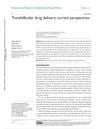TLDR The data set helps improve predictions of how substances are absorbed through pig skin.
The document presented a detailed database of porcine skin anatomical and physiological parameters to aid in the development of physiologically based pharmacokinetic (PBPK) models, particularly the Multi-phase Multi-layer Mechanistic Dermal Absorption (MPML MechDermA) Model. It included 14 parameters such as skin surface pH, stratum corneum thickness, and hair follicle density, essential for modeling dermal absorption and facilitating interspecies extrapolation. Data were sourced from 49 publications to improve the accuracy of PBPK models and predict dermatokinetic properties in in vitro permeation testing (IVPT) experiments, despite some limitations due to inconsistencies in nomenclature and methods.
 149 citations
,
September 2017 in “Pharmaceutics”
149 citations
,
September 2017 in “Pharmaceutics” Pig skin is a good substitute for human skin to measure drug absorption, but differences in skin structure and enzymes across species must be considered.
353 citations
,
November 2014 in “Molecular immunology” Porcine skin is very similar to human skin, making it a useful model for research.
 38 citations
,
June 2018 in “Archives of Toxicology”
38 citations
,
June 2018 in “Archives of Toxicology” Different species and human skin models vary in their skin enzyme activities, with pig skin and some models closely matching human skin, useful for safety assessments and understanding the skin's protective roles.
 5 citations
,
May 2020 in “Pharmaceutical Research”
5 citations
,
May 2020 in “Pharmaceutical Research” Heat and chemicals improve finasteride delivery to scalp and hair follicles, potentially enhancing treatment for hair loss.
 10 citations
,
April 2016 in “Research and reports in transdermal drug delivery”
10 citations
,
April 2016 in “Research and reports in transdermal drug delivery” Transfollicular drug delivery is promising but needs more research to improve and understand it better.
1 citations
,
February 2023 in “Applied sciences” The new topical growth hormone formula has high skin penetration and bioavailability.
 122 citations
,
April 2011 in “European Journal of Pharmaceutics and Biopharmaceutics”
122 citations
,
April 2011 in “European Journal of Pharmaceutics and Biopharmaceutics” Particles around 100 nm can penetrate and stay in hair follicles without passing through healthy skin, making them safe for use in topical products and useful for targeted drug delivery.




